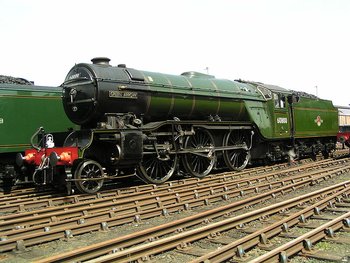LNER Class V2

The London and North Eastern Railway (LNER) Class V2 2-6-2 steam locomotives were designed by Sir Nigel Gresley for express mixed traffic work, and built between 1936–1944. The best known is the first of the class, 4771 (later 800 and 60800) Green Arrow, which is the only preserved example.
http://en.wikipedia.org/wiki/LNER_Class_V2
Sound Projects
project for BR and L.N.E.R CLASS V2 STEAM ENGINE 16 BIT copyright (C)
project: BR :L.N.E.R V2 Steam Engine
AUTHOR :Barry T Gaskin
function key operations
F0- Lights
F1- Short Whistle- leave F1 latched ON to allow automatic whistles on start
F2- Whistle
F3- Coal Shovel cycle- Leave F3 ON to allow automatic coaling set by CV147
F4- Vacuum pump manual ON (when moving)
F5- Water injector
F6- Steam Cylinder Blowdown
F7- Wheelslip
F8- Mute control, [F8 ON is muted.]
F9- Brake squeal
F10- Power Sander
F11- Power Greaser- When speed=0!
F12- Safety Steam Blowoff
(B) British V2 steam engine (cv,s) [decoder CV8=8 reset value in brackets]
CV58 Master Volume, 0-15, 0= max, (F8 used for Mute) [9]
CV60 Scheme select CV, 0=Steam, [0]
CV121 Software Version, MUST be 2 or higher [3] (Read Only Value)
CV122 Product TYpe, 12 = Digitrax SFX sound decoder Read Only Value
CV123 Hardware Version, 17= SDH104K1 decdoer Read Only Value
CV124 Flash Signature [2] (Read Only Value)
CV125 16KB free blocks [0] (Read Only Value)
CV126 FAT flags [7] (Read Only Value)
CV127 Internal Flags [0] (Read Only Value)
CV128 IPL counter [0] (Read Only Value)
CV133 Steam Chuff/CAM config, 128=>EXT cam, 1-127=>DRIVER dia in inches[72]
CV134 Steam gear ratio trim, 32=100% ratio, [32]
CV135 Volume when Muted 0-64 [0]
User configurable SoundCV's:
CV140 PRIME mover chuff vol 0-64 [60]
CV142 WHISTLE vol 0-64 [60]
CV143 Air features vol (popoff,drier,comp) 0-64 [30]
CV145 Coal/Sander vols 0-64 [40]
CV147 Coal Shovel rate, (1= about 2secs) 1-64 [50]
CV148 Water Injector rate [30]
CV149 Vacuum Pump rate [25]
CV150 Whistle Selector,0=std , 1=Playable volume [0]
CV152 Author ID Digitrax=0xDD/221 [221]
CV153 Project ID STD5 [18]
CV154 Steam Blowdown/Safety vol 0-64 [60]
CV160 Variant ID [4]
(C) General Notes
Some sound recording courtesy of Steam Sounds UK and recorded by D Bailey 2003. Additional sound editing B T Gaskin all sounds in this project have been reworked in 16 Bit sample rate from the original locomotive sound recordings
Each engine has a distinct 'personality', so a particular locomotive example may sound slightly different due to unique e.g. tappet, crank-rate shell vibrations and exhaust-stack, chuff differences. Horns and bells are often moved between locomotives.
------[end BR V2l SDF/DECODER definition]--------------
SoundLoader Software
Using your PR3 programmer and SoundLoader Software, it’s quick and easy to download sound project files into your Digitrax FX decoders.
Format Information
With Digitrax Sound FX decoders and downloadable sound project files (.spj), you can download your choice of sound schemes into any Sound FX equipped locomotive. You can use spj’s that are available for free, you can modify those schemes or you can create your own!
Sound Decoders
Digitrax offers a wide variety of Sound FX decoders to fit many different locomotives. You’ll need to have a Digitrax SFX decoder installed to take advantage of using .spj files.
Click here for Digitrax Sound FX decodersSubmit your Sound Projects
Use our submission form to submit your Sound Projects

Click here to submit your sound project